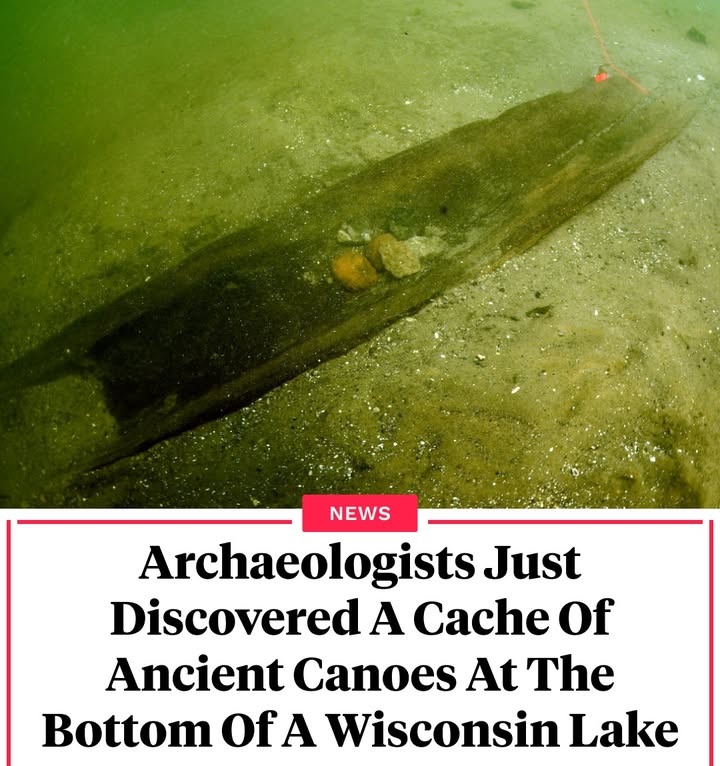Since 2021, researchers from the Wisconsin Historical Society have been uncovering a remarkable collection of ancient canoes submerged beneath Lake Mendota in Madison, Wisconsin, revealing centuries of Native American history that had long been hidden underwater. This exciting discovery includes as many as 11 canoes, with the oldest dugout estimated to be around 4,500 years old, making it the oldest canoe of its kind ever found in the Great Lakes region.

These canoes offer a fascinating glimpse into the lives and traditions of Indigenous peoples who lived in the area thousands of years ago, shedding new light on their travel, craftsmanship, and way of life. The initial find came in 2021 when archaeologists pulled a 1,200-year-old canoe from the lake’s depths. This discovery was soon followed by another canoe recovered in 2022, believed to be roughly 3,000 years old, which at the time was considered the oldest canoe found in the region. Encouraged by these early successes, the team collaborated with Native Nations across Wisconsin to continue diving expeditions, and they soon realized the number of canoes was far greater than originally thought. State archaeologist Amy Rosebrough explained that it became clear they weren’t looking at just one or two canoes, but rather an entire assemblage of vessels, each with its own unique age and characteristics.
Among these, fragments from up to nine additional canoes have been identified, spanning a wide timeline from around 2500 B.C.E. to approximately 1250 C.E., the latter being made from red oak and nearly 800 years old. This vast range demonstrates that dugout canoe use in the region persisted across millennia, evolving through different cultural periods. The oldest canoe, carved from elm wood, dates back to the Late Archaic period, roughly 4,500 years ago, well before the introduction of farming or the construction of burial mounds in the area. This means Indigenous peoples were utilizing sophisticated watercraft long before many of the societal developments commonly associated with later periods. Researchers believe these canoes were intentionally sunk in shallow waters each autumn as a preservation method during the winter months, only to be retrieved and used again in the spring.
Over centuries, natural changes to the shoreline, caused by droughts, floods, and sediment buildup, eventually buried these canoes beneath layers of lakebed soil, preserving them until their recent rediscovery. While the canoes answer many questions about ancient travel and life, they also raise new ones. Rosebrough wonders if this could just be the beginning and if a “bathtub ring” of similar canoes might circle the entirety of Lake Mendota or exist in other lakes across the region. The discovery confirms long-held assumptions that dugout canoes were a common and vital mode of transportation for Native peoples during the Late Archaic period and beyond. The canoes were found within the ancestral territory of the Ho-Chunk Nation, and while the specific identities of the people who built them remain unknown due to the vast stretch of time involved, the artifacts tell the enduring story of Indigenous presence in the area.
The collection also includes canoes from later periods, such as the Middle Woodland period, when early farming, pottery, and mound-building were underway, and the Late Woodland period, marked by more widespread corn agriculture and effigy mounds. The most recent canoe dates from the Oneota period, known for permanent farming settlements and complex social structures. Advanced technology like ground-penetrating radar has aided researchers and tribal partners in mapping these artifacts without disturbing their fragile condition. Bill Quackenbush, historic preservation officer for the Ho-Chunk Nation, emphasized how these physical finds connect with the rich oral traditions passed down through generations, highlighting the ingenuity and deep history of their ancestors. The first two recovered canoes are slated for conservation at Texas A&M University, where they will be freeze-dried and eventually displayed in the Wisconsin History Center opening in 2027. However, more fragile canoe fragments will remain in place to preserve their delicate state, while sonar mapping continues to explore what else lies beneath the lake’s surface. For many, these canoes make ancient history tangible and relatable. As Rosebrough noted, a 5,000-year-old spearpoint might not capture the imagination as much as a canoe—a recognizable, everyday object—helps people envision the lives of the people who built and used them. This connection bridges thousands of years and deepens appreciation for the Native peoples who have called this region home for millennia. The discovery of these canoes is not just an archaeological achievement but also a reminder of the enduring legacy and presence of Indigenous cultures in the Great Lakes area.





